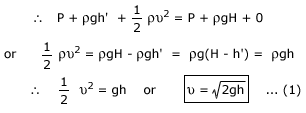Derivation
Applying Bernoulli's theorem,
Total energy per unit volume at the orifice = Total energy per unit volume at free surface

Which is the equation for the velocity of efflux.
Let a body fall freely from the level of free surface of the liquid. Let V be the velocity
acquired by the body when it reaches the level of orifice
Now, 'u' = 0, 'v' = V, 'a' = g, 'S' = h

From equation (1) and (2), v = V
So, the velocity of efflux of a liquid is equal to the velocity acquired by the body in
falling freely from the free surface of the liquid to the orifice.
This proves Torricelli's theorem.
Horizontal range: The escaping liquid flows in the form of a parabola. Let t be the time take by the liquid to fall through a height h'.

Let R be the horizontal range. In order to calculate R, we shall consider the horizontal
motion of the projectile. The horizontal motion and taked place with constant velocity v.

For a given height of the liquid column, this range is maximum when h = h'.
If the liquid jet is directed upward, it should rise to the level of free surface of the
liquid. But due to viscosity and air resistance , the actual height is always less.